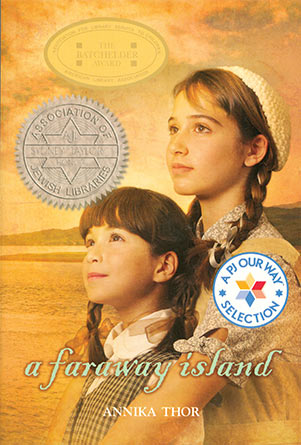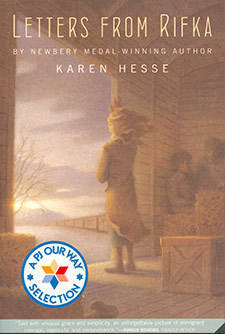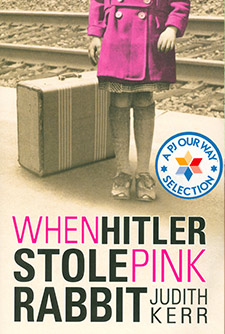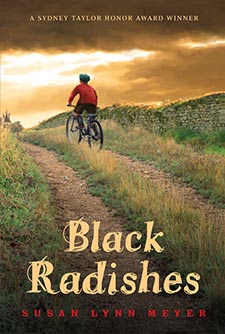A Faraway Island
It’s not safe for Jews in Vienna, so Stephie and her little sister, Nellie, have to start a new life on a tiny Swedish island. But Stephie can’t speak the language, Aunt Marta is so strict, and everything smells of fish! How will she ever fit in?
Average Rating
( hint: Login to leave a review! )
123 Reviews
Leave Review
What the Book is About
Jewish Content & Values
Positive Role Models
Content Advisory
Talk it Over!
More for You
Twelve-year-old Stephie and her little sister Nellie are sent from Nazi-occupied Vienna to foster homes on a tiny, remote island off the coast of Sweden. Nellie picks up the language easily and soon feels at home, but Stephie finds it difficult to make friends at school and to live up to strict Aunt Marta’s standards. Although there is the tension of Stephie’s worry about her parents, for the most part this is a universal story of a bookish girl trying to fit into a new environment. The island backdrop and Stephie’s stern foster mother and kindly foster father are reminiscent of the classic Anne of Green Gables. The author is Swedish-Jewish and this is the first book in a series.
- Stephie recalls the anti-Semitism that Jewish children experienced at school in Vienna and the restrictions imposed on Jewish families. Letters from her father keep her updated on the situation for Jews trying to leave the country.
- Stephie describes going to synagogue in Vienna on the High Holidays.
- Uncle Evert is kind and encouraging to Stephie. When he first meets her, he speaks to her in his limited German, and he teaches her to row and to fish. When the school year is about to start, he buys her a beautiful new pencil case even though the family finances are tight. He writes to his representative in Parliament seeking permission for Stephie’s parents to come to Sweden.
- Miss Bergstrom is Stephie’s teacher. She makes Stephie welcome in the classroom and asks the children to be kind to the new girl. She encourages Stephie to go to the high school for academically gifted children and lends her the books she will need for the exam.
Stephie recalls a scene back in Vienna when the Nazis stormed into the family home and shot their dog. At one point, the girls are converted to Christianity by their host families, but it is clear from the context that they are pressured into it and still see themselves as Jewish. Although the story does not dwell too much on the underlying uncertainty and tension regarding her parent’s fate back in Vienna, it’s clearly a concern.
Vera tells Stephie that she will teach her to ride a bicycle so that the girls can ride together, but when Stephie arrives at school the next day, she sees Vera at the center of a crowd imitating Stephie’s reaction when she fell off her bike. Why do you think Vera did that? How would you have responded if you were Stephie?
Before 1718, everyone living in Sweden had to be a Protestant Lutheran. The law was changed when the king owed money to Jewish and Muslim creditors, but for many years Jews were only allowed to live in three cities. Between 1933 and 1939, around 3,000 Jewish people fled to Sweden to escape the Nazis, including 500 children on the Kindertransport. Today, approximately 20,000 Jews live in Sweden.
What the Book is About
Twelve-year-old Stephie and her little sister Nellie are sent from Nazi-occupied Vienna to foster homes on a tiny, remote island off the coast of Sweden. Nellie picks up the language easily and soon feels at home, but Stephie finds it difficult to make friends at school and to live up to strict Aunt Marta’s standards. Although there is the tension of Stephie’s worry about her parents, for the most part this is a universal story of a bookish girl trying to fit into a new environment. The island backdrop and Stephie’s stern foster mother and kindly foster father are reminiscent of the classic Anne of Green Gables. The author is Swedish-Jewish and this is the first book in a series.
Jewish Content & Values
- Stephie recalls the anti-Semitism that Jewish children experienced at school in Vienna and the restrictions imposed on Jewish families. Letters from her father keep her updated on the situation for Jews trying to leave the country.
- Stephie describes going to synagogue in Vienna on the High Holidays.
Positive Role Models
- Uncle Evert is kind and encouraging to Stephie. When he first meets her, he speaks to her in his limited German, and he teaches her to row and to fish. When the school year is about to start, he buys her a beautiful new pencil case even though the family finances are tight. He writes to his representative in Parliament seeking permission for Stephie’s parents to come to Sweden.
- Miss Bergstrom is Stephie’s teacher. She makes Stephie welcome in the classroom and asks the children to be kind to the new girl. She encourages Stephie to go to the high school for academically gifted children and lends her the books she will need for the exam.
Content Advisory
Stephie recalls a scene back in Vienna when the Nazis stormed into the family home and shot their dog. At one point, the girls are converted to Christianity by their host families, but it is clear from the context that they are pressured into it and still see themselves as Jewish. Although the story does not dwell too much on the underlying uncertainty and tension regarding her parent’s fate back in Vienna, it’s clearly a concern.
Talk it Over!
Vera tells Stephie that she will teach her to ride a bicycle so that the girls can ride together, but when Stephie arrives at school the next day, she sees Vera at the center of a crowd imitating Stephie’s reaction when she fell off her bike. Why do you think Vera did that? How would you have responded if you were Stephie?
More for You
Before 1718, everyone living in Sweden had to be a Protestant Lutheran. The law was changed when the king owed money to Jewish and Muslim creditors, but for many years Jews were only allowed to live in three cities. Between 1933 and 1939, around 3,000 Jewish people fled to Sweden to escape the Nazis, including 500 children on the Kindertransport. Today, approximately 20,000 Jews live in Sweden.




